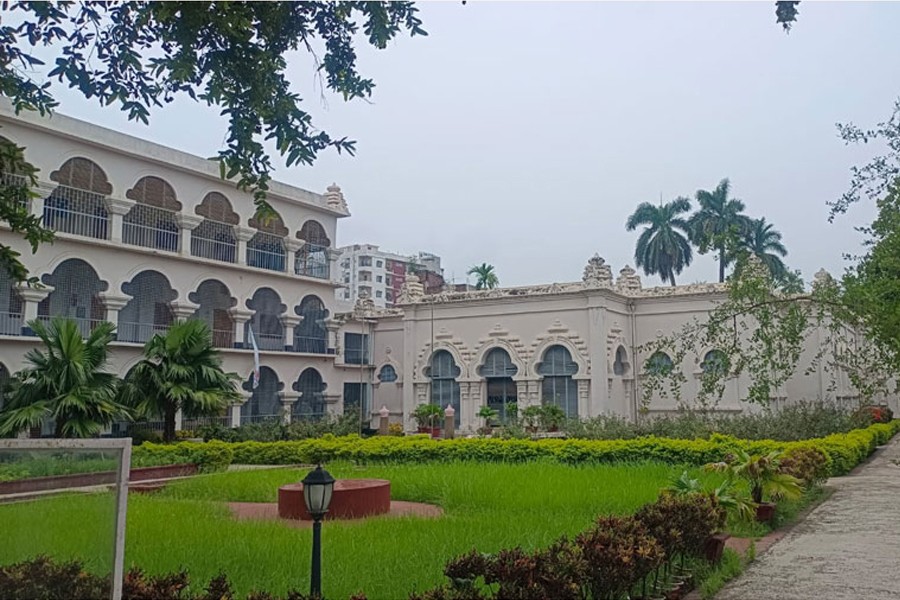
Rajshahi Varendra Research Museum comes to no harm in student protests
With a rich collection of rare artifacts, the institution bears testimony to ancient traditions
OUR CORRESPONDENT | Monday, 12 August 2024

RAJSHAHI, Aug 11: Since after Sheikh Hasina resigned from the post of Prime Minister and left the country on August 05, Varendra Research Museum of Rajshahi, the country's first and one of the main archaeological museums in South Asia, has remained unharmed despite the incidents of attack, vandalism, arson and looting in various public and private-owned buildings in the district and elsewhere.
The institution was saved from damage at the intervention of the activists of the Anti-Discrimination Student Movement, local youths, members of the armed forces, officials of related offices, members of Ansar and Red Crescent.
However, the museum at the movement has been kept shut to avoid the unwanted situation stemming out from the movement.
It is learnt, after the fall of the Awami League government on August 05, incidents of attack, vandalism, arson and looting started happening across the country.
In continuation of the mayhem, the Rajshahi City Corporation Building, the Rajshahi Metropolitan Police Headquarters, the city Awami League office, residences of different Awami League leaders and activists including the mayor, all police stations and police stations in the city, Star Cineplex in the Hi-Tech Park and several public and private establishments were vandalised, looted and set afire; but the Varendra Research Museum survived.
The museum with a rich collection of rare artifacts has been bearing the testimony to traditions of ages.
Located in front of Hetamkhan Sadar Hospital, in the heart of Rajshahi city, the museum bears the evidence of several thousand years' civilisations, including those of the Pal, Sen, Maurya and Gupta periods.
The museum was established in 1910 with efforts of Zamindar Kumar Sarathkumar Roy of the Dighapatia royal family of Natore, the famous lawyer historian Akshay Kumar Maitreya and Ramaprasad Chandra, a teacher of Rajshahi Collegiate School.
From the latter half of the nineteenth century, the conscious society of that time became enthusiastic for the preservation and restoration of history, tradition, literature, culture.
As a result, Bengali Sahitya Parishad was established to collect and practise almost forgotten literary artifacts and historical and archaeological artifacts.
The first session of Kasimbazar Parishad of West Bengal was held in 1908 at the initiative of Rabindranath Tagore.
The second session of the Parishad was held in Bhagalpur the following year.
Sarathkumar Roy, Akshay Kumar Maitreya and Ramaprasad attended both the sessions and presented enlightening articles on Barendrabhumi's archeology and became passionate about archaeology.
In 1910, they went on an archaeological expedition to Khanjanpur in Bogura district and reached a consensus to form a society to collect and preserve its heritage and formed Barendra Research Society.
The association conducted research and collected 32 rare archeological artifacts including the famous black stone Gangamurti from various places of Rajshahi district.
Construction of a museum building to preserve the collected artifacts became essential and Sarathkumar started the construction at the request of his friends despite knowing that it would be expensive.
The then Governor of Bengal Lord Carmichael laid the foundation stone on 13 November 1916 at the request of the officials of the association. After the construction, it was inaugurated by Lord Ronaldsay on November 27, 1919.
The Rajshahi Varendra Research Museum has a collection of about 19,000 historical artifacts including stones and metal sculptures, terracotta, coins and manuscripts, pottery and terracotta plaques, weapons, Arabic and Persian documents, paintings, metal objects and inscriptions.
The museum has seven galleries to display the artifacts. The gallery exhibits artifacts from the Indus Civilisation (2500 BC), which includes, Persian decrees and Bengali documents, Sanskrit script in old Bengali script, glazed tiles, Islamic metal lamps, handwritten Quran, Bengali and Sanskrit manuscripts, artifacts excavated at Paharpur (8th-12th century) in Bangladesh, Mughal paintings, stone and bronze sculptures, ancient artifacts found at Nalanda in Bihar and other places in India.
Even there are stone statues of Hindu and Buddhist deities and modern wooden sculptures. On display are Hindu sculptures, Surya idols, Shiva idols, Ganesha idols and Vishnu idols. Durga-Gauri-Uma- Parvati, Matrika and Chamunda idols. Buddhist idols, Bodhisattvas, Tara, Jain Tirthankaras and Hindu deities.
Mohiuddin, Ansar commander in charge of Varendra Museum, said, "Along with us, ordinary students are also guarding the museum day and night. Besides, army men and local people are also vigilant to protect it. As a result, the ongoing crisis could not affect the museum."
anaetru@gmail.com